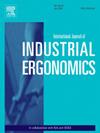Postural stability and risk of slips in lifting tasks: Effects of load weight and load knowledge
IF 3
2区 工程技术
Q2 ENGINEERING, INDUSTRIAL
International Journal of Industrial Ergonomics
Pub Date : 2025-01-01
DOI:10.1016/j.ergon.2024.103675
引用次数: 0
Abstract
Load transfer during lifting leads to increased postural perturbations that may compromise postural stability, so lifting is an occupational task associated with high fall risk. This study aimed to gain improved knowledge about fall risk in lifting tasks. The effects of both load weight and load knowledge were examined. Load weight was set at three levels according to individuals' maximum acceptable lifting capacity. Unlike previous studies, load knowledge was set by considering load material fragility. Twenty-four male participants were involved in the experimental study, in which they were instructed to perform both symmetric and asymmetric lifting tasks under conditions defined by various combinations of load weight and load knowledge. Fall risk was assessed by using measures accounting for postural stability and risk of slips. The results showed that when being defined near individuals’ maximum acceptable lifting capacity, increased lifting load weight not only improved postural stability in the rising phase of lifting, but also increased the risk of slips. These findings suggest that improved postural stability due to increased load weight in the rising phase could be a compensatory postural control strategy for the increased risk of slips so as to maintain balance and avoid the occurrence of a potential fall. We also found that load knowledge of fragility and weight may not contribute to fall risk reduction during lifting. The findings obtained from the present study are useful for practitioners to design safe lifting tasks.
在起重任务中的姿势稳定性和滑倒风险:负载重量和负载知识的影响
举重过程中的负荷转移会导致姿势扰动增加,从而损害姿势稳定性,因此举重是一项与高跌倒风险相关的职业任务。这项研究旨在提高人们对举重运动中跌倒风险的认识。考察了载荷重量和载荷知识的影响。根据个人的最大可接受的起重能力,将负载重量设置为三个级别。与以往的研究不同,载荷知识是通过考虑载荷材料的脆性来设定的。24名男性参与者参与了实验研究,在实验中,他们被指示在由各种负载重量和负载知识组合定义的条件下执行对称和非对称的举重任务。跌倒风险的评估采用了考虑姿势稳定性和滑倒风险的措施。结果表明,在接近个体最大可接受起重能力时,增加的起重载荷不仅提高了起重上升阶段的姿势稳定性,而且增加了滑倒的风险。这些发现表明,在上升阶段,由于负重增加而提高的姿势稳定性可能是一种代偿性的姿势控制策略,以控制滑移风险的增加,从而保持平衡,避免潜在跌倒的发生。我们还发现,对易碎性和重量的负荷知识可能无助于降低举重过程中摔倒的风险。本研究的结果可为从业员设计安全的起重作业提供参考。
本文章由计算机程序翻译,如有差异,请以英文原文为准。
求助全文
约1分钟内获得全文
求助全文
来源期刊
CiteScore
6.40
自引率
12.90%
发文量
110
审稿时长
56 days
期刊介绍:
The journal publishes original contributions that add to our understanding of the role of humans in today systems and the interactions thereof with various system components. The journal typically covers the following areas: industrial and occupational ergonomics, design of systems, tools and equipment, human performance measurement and modeling, human productivity, humans in technologically complex systems, and safety. The focus of the articles includes basic theoretical advances, applications, case studies, new methodologies and procedures; and empirical studies.

 求助内容:
求助内容: 应助结果提醒方式:
应助结果提醒方式:


